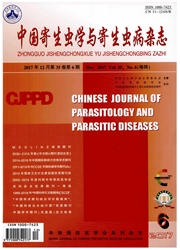

 中文摘要:
中文摘要:
目的 对1例输入性非洲锥虫病患者进行实验室诊断与病原体鉴定。 方法 收集患者的临床发病与流行病学调查资料,采集血样、脑脊液,瑞氏-吉氏染色涂片后镜检。用布氏锥虫(Trypanosoma brucei)表达位点相关基因(ESAG)、布氏锥虫冈比亚亚种(T. b. gambiense)特异性糖蛋白(TgsGP)和18S rRNA(M18S-Ⅱ-Tb)基因、布氏锥虫罗得西亚种(T. b. rhodesiense)特异性血清抗性相关(SRA)基因的特异性引物扩增患者血样基因组DNA。另进行血常规、脑脊液常规、血生化、血免疫等实验室检查。 结果 患者双下肢无力伴浅表淋巴结肿大4月余,入院时嗜睡,偶有情绪异常,伴贫血(血红蛋白85 g/L)、电解质紊乱(钠124 mmol/L、氯87 mmol/L)、非特异性免疫球蛋白显著增高(球蛋白63 g/L)等表现。流行病学调查示,患者有非洲加蓬共和国务工史,期间有数次昆虫叮咬史。患者外周血镜检查见锥虫鞭毛体。PCR扩增结果示,ESAG、TgsGP和M18S-Ⅱ-Tb基因的特异性引物分别扩增出286、308、150 bp的条带。 结论 综合患者的临床资料、流行病学史、病原学和PCR检测结果,确诊为布氏冈比亚锥虫病。
 英文摘要:
英文摘要:
Objective To perform laboratory diagnosis for an imported case of human African trypanosomiasis and identify the pathogen. Methods Clinical and epidemiological information was collected. Blood and cerebrospinal fluid samples were collected, stained with Wright-Giemsa, and microscopically examined. Genomic DNA from the blood samples was amplified with primers specific for Trypanosoma sp. expression site-associated gene(ESAG), Trypanosoma brucei gambiense specific glycoprotein(TgsGP) and 18S rRNA(M18S-Ⅱ-Tb) gene, and Trypanosoma brucei rhodesiense specific serum resistance associated (SRA) gene. Complete blood count, blood chemistry, and CSF examination were also conducted. Results The patient had a 4-month history of lower extremity weakness and swelling of surface lymph nodes. Physical examination showed somnolence, and occasional emotional abnormalities, accompanied by anemia(hemoglobin 85 g/L), electrolyte disturbance(sodium 124 mmol/L; chlorine 87 mmol/L) and significantly increased nonspecific immune globulin protein (globulin 63 g/L). Epidemiological survey showed that the patient suffered insect bites and stings for several times during his work in the Republic of Gabon in Africa. Microscopic examination revealed flagella of trypanosome in peripheral blood. PCR amplification produced bands of 286, 308, and 150 bp with primers specific for ESAG, TgsGP and M18S-Ⅱ-Tb, respectively. Conclusion The patient was diagnosed with Trypanosoma brucei gambiense infection from the clinical information, epidemiological history, etiology and PCR results.
 同期刊论文项目
同期刊论文项目
 同项目期刊论文
同项目期刊论文
 期刊信息
期刊信息
